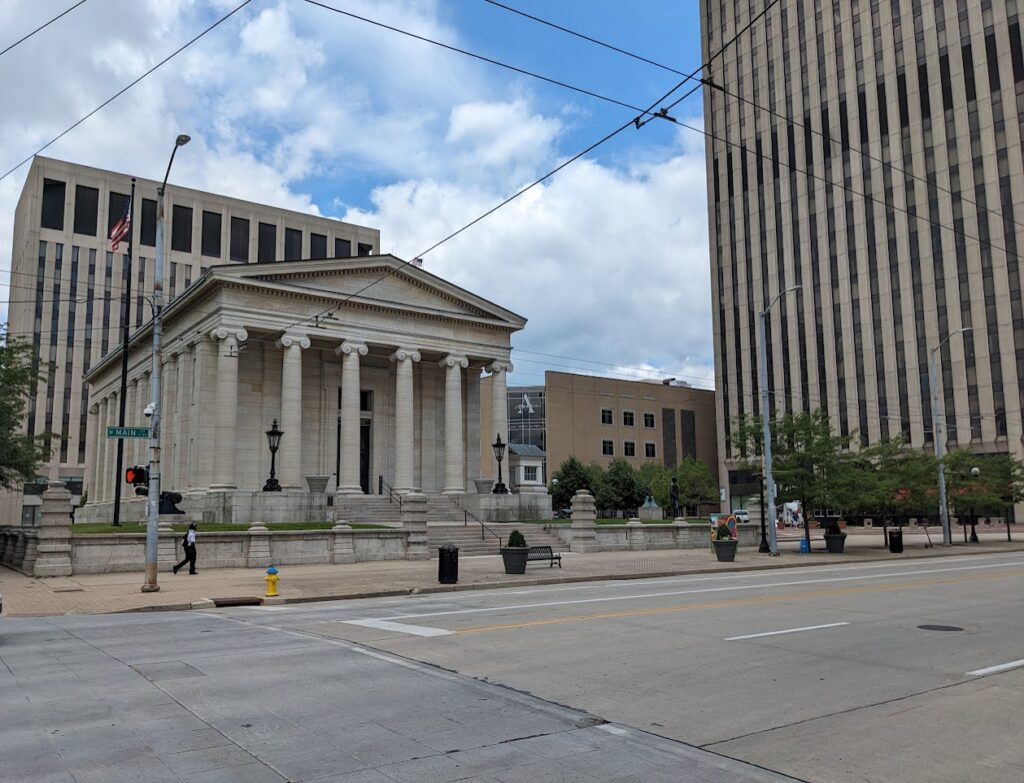
In my last article, I retraced the history of Dayton’s Courthouse Square. Now I’ll take us from its opening in 1974 to the present day, as well as reflect on possibilities for the future.
The Square: From the 1970s to Today
Courthouse Square has had a rocky 50 years of existence, which largely echoes the experience of downtown Dayton as a whole. A key factor has been the decline in the downtown office population coupled with fewer retail stores and attractions that bring in regular foot traffic.
Courthouse Square was considered a major risk since its conception due to the amount of public money involved, as well as the fact that Dayton’s suburbs had already started to wrest influence away from downtown. Scores of Daytonians were moving to the new suburbs and shopping malls sprang up to serve them there, making a trip downtown unnecessary. Town & Country in Kettering opened all the way back in 1951, and larger enclosed malls followed such as the Salem Mall in 1966 and the Dayton Mall in 1970. Even downtown anchor Rike’s Department Store, just across 2nd St. from the square, began to open suburban stores around this time.
Courthouse Square was also intended to connect key downtown shopping areas nearby. The Dayton Arcade, directly across 3rd St, was hit hard by suburban flight as well, but it was added to the National Register of Historic Places in 1975 and a major redevelopment was completed in 1980. It focused on retail, but the upper-floor apartments never reopened as planned. While a new food court proved popular, the rest of the complex never picked up: by the late 80s, over half of the retail spaces were vacant, and the Arcade shut its doors in 1991. The downtown Rike’s, at that point renamed Lazarus, closed later that year and was eventually demolished for the Schuster Center. As for the Elder-Beerman store, which was a major part of the Courthouse Square project in the 1970s? It was the last department store in downtown Dayton when it closed in 2002.
Office vacancies were an issue even when Courthouse Square first opened. To qualify for financing for the development’s signature tower, Mead had to lease over 125,000 square feet of space it wouldn’t be using. And a study at that time estimated that 300,000 square feet of vacant office space already existed elsewhere downtown. This emptying out of offices would continue even as new skyscrapers were built: the tower at Main and 3rd was completed in 1989 in an attempt to provide an influx of workers to the center of downtown; however, the tower at 110 N. Main opened the very same year, resulting in a glut of space that far exceeded the declining demand.
These larger trends are necessary context for any discussions about the success (or failure) of Courthouse Square.
In an article written in 1982, 8 years after its opening, one columnist called the square “the center of attention and attraction” and the “major downtown thoroughfare for pedestrian traffic.” The biggest crowds gathered at lunchtime, but other activities “keep the business crowd downtown on Friday nights and bring people from the suburbs into the city.” However, the article also stated that the square didn’t attract enough people for Arcade merchants to open on Sundays. It also reported that the original two restaurants in the basement space had gone out of business that year.
Reflecting on Courthouse Square’s first decade, a 1984 article took a slightly less positive tone, arguing that “it did not become the people-magnet that others promised” but noting, “It has at least become a social center on rainless days and some weekend nights.”
To celebrate the complex’s 15th anniversary in 1989, thousands attended a Friday night rock concert, a review of which called the square “the most popular, active space in downtown Dayton.” Despite that activity, in 1991 the two underground restaurants, which had reopened with a new operator, closed again after Mead decided to stop subsidizing their “substantial” losses. A spokesperson said, “From the beginning it has been an uphill attempt to make the restaurants viable” and that despite a lot of hard work, “The operations just have never flourished” (“Underground Restaurants in Courthouse Square to Close,” DDN, 1/16/91).
A few years later, the struggles began to creep into the Mead Tower itself and the company’s overall operations in Dayton. In early 2001, when the future of Mead’s lease was uncertain, a company’s VP assured that “we are committed to the city of Dayton,” but just six months later Mead shocked the region by announcing a merger with Westvaco and moving its headquarters to Connecticut. One business owner who contracted with Mead described the move: “Psychologically, it is devastating to downtown and Dayton. This downtown was looking positive, and to have someone like that leave the area is like hitting a major bump in the road. It is not encouraging at all.” At first, the company said it was consolidating its paper operations here and that “Dayton is going to be even more important to MeadWestvaco going forward.” In reality, by 2006 the company had vacated the tower and cut its total regional work force by 70%.
The building subsequently became the Keybank Tower, but other key tenants continued to pull out: law firm Thompson Hine moved its 100 employees to Austin Landing in 2011 despite major efforts to keep it downtown. Recently the bank itself has pulled out too, closing its branch in 2021 and leaving the tower in 2023 for a new office.
These office and retail trends are undoubtedly major factors in the situation in which Courthouse Square finds itself today, and effects of the COVID-19 pandemic have also led to fewer downtown office workers, especially for major employers like Premier Health and CareSource. It also contributed to the recent closures of the Boston Stoker coffee shop on Courthouse Square and the popular Carmen’s Deli just across Main St.
Courthouse Square: A Shell of What It Once Was?
In recent articles about Courthouse Square, the tone has turned much more negative. It’s empty nearly all the time—a shell of what it once was. Officials have even said that the current square is actively hindering downtown revitalization efforts and have pushed for a radical re-visioning of the space. This spring, a group of local organizations held visioning sessions for how to reinvigorate the property, and ideas included everything from a dog park to pop-up comedy shows.
But it’s interesting to reread the articles from the 1980s, when Courthouse Square was largely considered a success, and compare them to today. Events and attendance still follow the same patterns: lunchtime events bring the majority of visitors and only periodically does the momentum persist after work hours or on weekends. Today, despite fewer office workers, the “Square is Where” lunchtime series still features music, yoga, trivia and more, and a variety of city festivals bring visitors to the square on the weekends.
“Courthouse Square is in the heart of downtown and it’s a natural gathering place, so we like to use it in our events when we can,” Lynn Robertson, special events manager with the Downtown Dayton Partnership, told Dayton Vistas. “It’s the main area for The Square Is Where, the Dayton Holiday Festival, and we were also able to make it one of our live performance areas during this year’s Art in the City.”
So if the programs and events haven’t actually changed that much over the years, what’s behind the stark contrasts in some of the language used to describe the square, from “the most popular, active space” downtown to a failure in need of a new identity?
Amid calls for a major transformation of Courthouse Square, it’s worth asking if that’s what the space truly needs, or if the main issue is with maintaining what’s already there.
Urban policy expert Aaron Renn, quoting a book on NYC’s Bryant Park by Andrew Manshel, points out that maintenance of these public spaces is the single most crucial factor in their success:
The first thing to consider isn’t how the space is going to be designed but rather how it is going to be managed. This is the opposite of the typical approach, in which cities spend millions of dollars on designs from big-name architects but skimp on maintenance … Providing the highest possible level of maintenance in a public space is the sine qua non of placemaking. It is job one. There is no substitute for it.
Physical maintenance follows from the ‘broken windows’ principle in which even seemingly insignificant physical damage such as a simple broken window signals disorder and likely tolerance of antisocial behavior. Well-maintained spaces, however, project social order and make people feel safe, which is a precondition to their being willing to use a public space.
To give an example from Bryant Park, “An immaculately maintained restroom became part of the park’s physical restoration, powerfully communicating a sense of stability to park users.”
Applying this thinking to Courthouse Square, it becomes painfully apparent that, for one, there are no public restrooms at all, but also that the signature fountain is shut off, not having been used at all for years. Simply bringing that back could have an even greater positive impact on the feel of the space than many of the proposed new amenities.
Officials have said they hope to make the square successful like Cincinnati’s Fountain Square. A key lesson to take, then, is how that city takes major pride in the fountain itself, as described on its website.
And if we take a critical look at current square activities, more details jump out. For one, the number of food trucks has decreased significantly in recent years; for most lunches today the only visitor is the reliable Courtland’s Mobile Grill. This year only a few tiny tables are brought out for seating, compared to the much larger tables and chairs with umbrellas that were there as recently as 2022.
So when we consider the ideas generated in the recent visioning sessions (adding “lighting, comfortable seating, colorful banners, signage, (and) public art” as well as “spaces where people can bring their dogs, a beer garden, pop-up breweries or bars, games and play areas … hosting a market, (and) pop-up comedy shows.”), we should certainly consider new ideas to reimagine the space, but it’s also crucial to remember the “broken windows” principle and consider that bolstering key infrastructure and reinvesting in current activities could provide just as much of a beneficial effect.
This is a common issue in urban projects—the allure of the “shiny new thing” versus maintaining the old things (this NYTimes opinion piece urges us to get excited about maintenance!). Renn also points out that “capital-project dollars are often easier to raise than operating funds.”
The Downtown Dayton Partnership has won a $75,000 grant from the Project for Public Spaces to help with placemaking efforts on the square.
“We’re excited to see what’s ahead for Courthouse Square” said Laura Woeste, director of strategic projects for the DDP about receiving the grant. “Our long-term goal is to make Courthouse Square a downtown destination that benefits everyone in our community.”
Renn’s point about the complexity of different pots of money is certainly a factor here; the DDP runs programming and the City of Dayton hosts festivals, but the square is operated by the Board of Montgomery County Commissioners, and past projects such as repairing pavers, limestone and the fountain and adding picnic tables and planters have been county capital improvements and budget items. Funding obtained from grants and other sources might pay for certain upgrades but not others.
As of the early 1980s, Courthouse Square was maintained with a $100,000 budget from the hotel and motel tax. A 2014 planning document states that just over $700,000 is transferred from the same tax fund to the Cultural Facilities Fund “to support Memorial Hall and Courthouse Square.” The current webpage for that tax, however, mentions the historic Old Courthouse but not the rest of the Square.
Finding an Identity for the Square Moving Forward
Another relevant trend is how Courthouse Square’s former identity as the central gathering place downtown has been diminished by other nearby public spaces that opened up later. In the 1970s, for example, there was a seasonal ice skating rink on the square; today that has moved to Riverscape. For free live music on summer evenings, Daytonians now head to an often-packed Levitt Pavilion, two blocks away from the square.
Therefore, in carving out Courthouse Square’s role, we should think of it not as the single gathering space for everything downtown, but a more specialized space, and ideally one that can partner, not compete, with others. So for example, to further brainstorm the “beer garden” suggestion, the new expanded DORA boundaries provides a great opportunity, and an outdoor after-work beer garden would add something new downtown. Since Levitt Pavilion shows start at 7 p.m., could the square host a post-work happy hour with a pre-show with a smaller local artist? What if attendees at the square got a beverage or merchandise coupon to take and use at Levitt?
Another factor that has the potential to reverse foot traffic declines and bring new visitors to the square is the progress of new downtown hotels. The Hilton Garden Hotel in the North Arcade is directly across 3rd Street from Courthouse Square and will include 91 rooms. Hotel Ardent at Main and 1st will add 120 rooms just two blocks away. And the new 134-room AC Marriott is located just a half mile away. Other newer tenants on and near the square, such as the PNC Arts Annex, can also help (I’ve seen kids there for summer arts camps heading to the square during lunch, for example).
Another tenant is Kevin Kelly, who made a major bet on Courthouse Square when he moved the Dayton International Peace Museum there in 2021.
“We are both concerned and excited by the future of the site,” he told Dayton Vistas.
“I agree that the changes do not have to be a complete reinvention, but a clear plan is needed that reflects the changes in Dayton and society post-Covid. I don’t think we will ever see office workers returning to the city as in the past. I would like to see fewer hardscapes and more grass and trees. There appears to be little motivation to fix the fountain. Like a broken window, it telegraphs that the county and city are okay with it. The fact that there are no public bathrooms is unforgivable.
The county may need to consider a viable private/public partnership to pay for and attract people back to the Square. The nearby Arcade and Hilton Hotel projects are reasons for hope, but there must be good incentives for driving downtown and paying to park. Cornhole is not it.
Kelly also expressed “appreciation for the Portland Loo going in right now on the east side of City Hall. The small, single, eco-friendly public toilet will certainly help, but not fix the issue.”
Other square stakeholders apply the maintenance issue from the square itself to the surrounding buildings. Chris Riegel, CEO of Stratacache and the owner of the Courthouse Plaza SW building in addition to the Stratacache (formerly Kettering) Tower, commented, “No one wants to be in an empty KeyBank building.” He told the Dayton Daily News, “I’m looking at the KeyBank tower right now, with weeds on the stairs, windows that haven’t been washed. You have to maintain and you have to upgrade.”
Finally, lurking under the surface of this discussion is some tension relating to who the space is being designed for. A “vibrant” space is often thought of as one filled with white-collar urban professionals or guests at high-end boutique hotels, but in reality the space’s most consistent population comes to the square from the nearby main bus hub. Concerns that have been raised about vagrancy and public safety can be legitimate, but taking them too far may be at odds with the goal of creating a space truly open to all Daytonians.
So let’s bring this article to a close with a lightning round of more ideas for Courthouse Square based on events that have been held in the past: a “Beach Party” (held in 1988), a “Big Pig Roast” to raise money for local food pantries (1982), and a chili cookoff (an annual event in the 80s, though it featured Texas-style rather than Cincinnati chili; in 1989 it even had a Cincinnati Bengals player as a judge).
What would you like to see done with Courthouse Square?

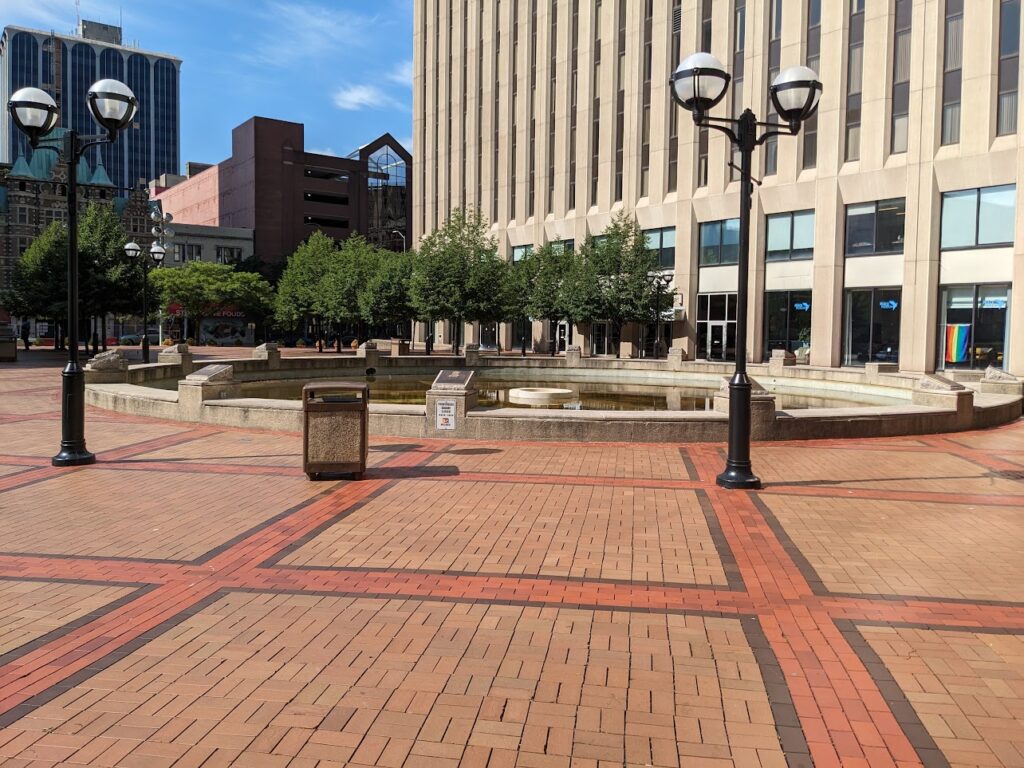

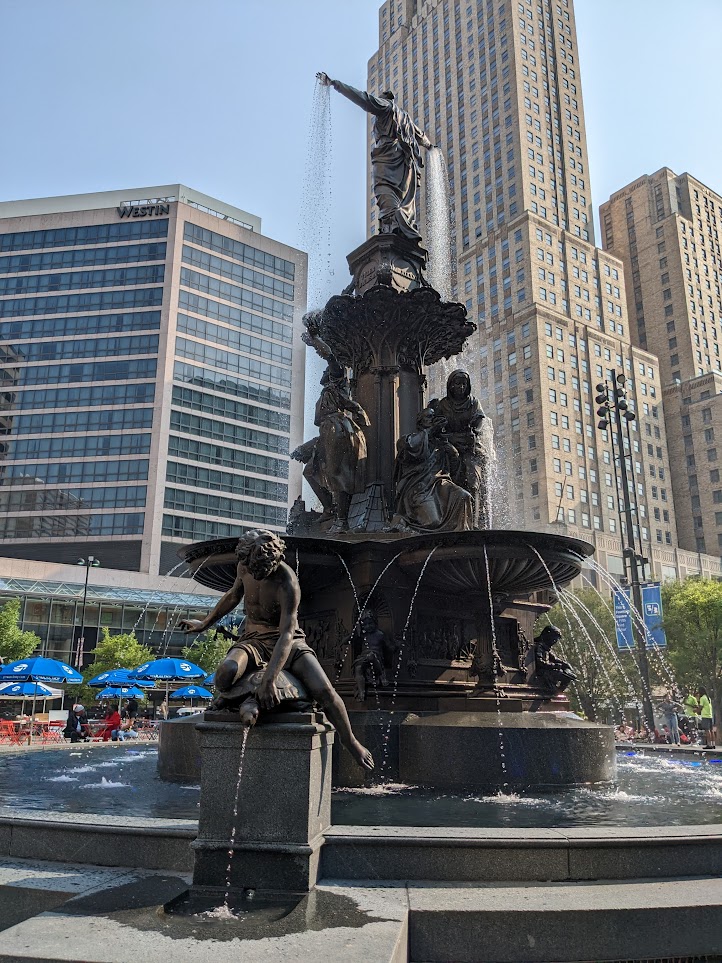
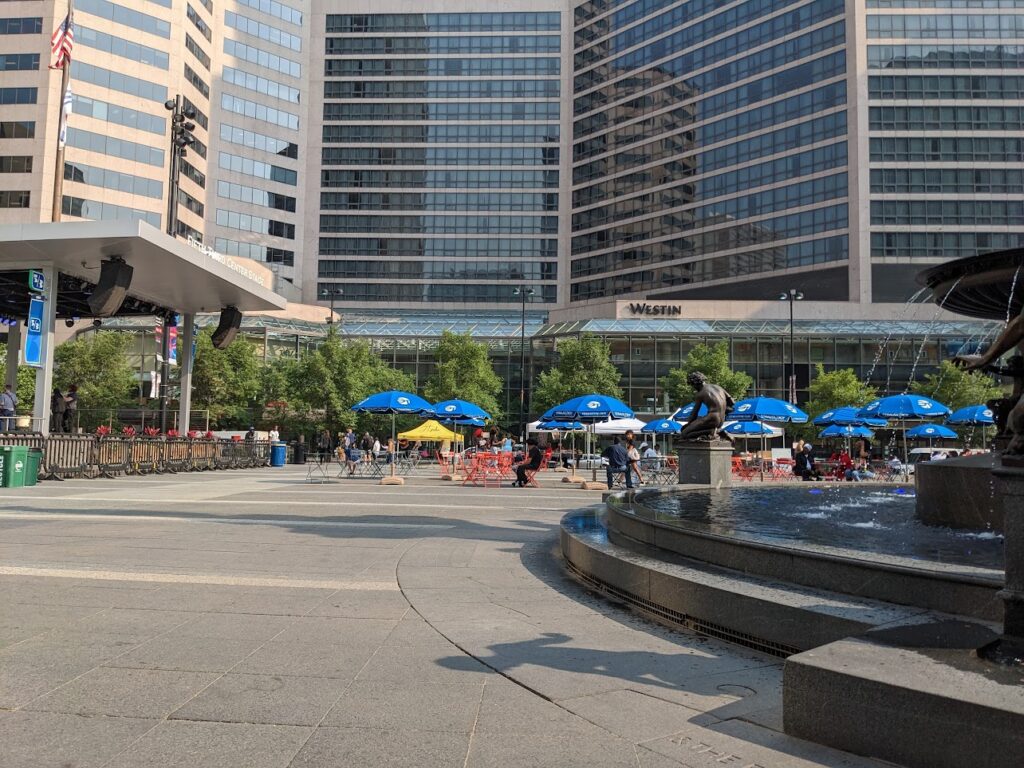

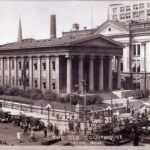

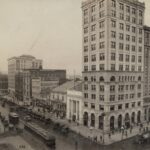
First of all, please stop making comparisons to Cincinnati. That downtown benefits from different forces and HQ’s (even though both cities’ squares were in part developed by the same company). It also hosts two major-league teams. Dayton could be inspired, however, by the centrality of a fountain. A redesigned fountain in the spirit of, say, the fountain at Lincoln Center in New York (which was itself redesigned in 2009) would be a point of attraction. It’s important to remember that Courthouse Square, which opened in two phases in 1974 and 1978, is a product of urban renewalism that included the razing of a vital city block – such a thing being antithetical to what a city is – a place of people and commerce.
The complexity of city life was harshly simplified (and thus exposed to the vagaries of change) when the square came into being. It curtailed any general use of it not connected to office life surrounding the square.
Without people nothing works. It is encouraging, then, that hundreds and even thousands of people are moving into the center city. They should be considered. I would encourage a complete rebuilding of the fountain, an addition of toilet facilities as you point out, and a general ability to sit and actually enjoy the square from a chair at a restaurant (protected by a roof or otherwise). It’s important to consider (aside from the broken window psychology) what a person actually experiences when entering a major city. Just what is it that they want? I think the usual applies the world over – liveliness, comforts, view, and food. There might also be a more profound connector to the Schuster Center and its offerings. Imagine Broadway previews on the square, classical nights (if not big-screen HD presentations of same from the Mead Theatre), and the sense that there is actually something there. In other words – use imagination and keep standards high. Do rebuild that fountain. Spend something on it. People will photograph it, and to photograph it they will have to walk to it; this is part of having a living city.
Back in the late 70’s/early 80’s there used to be a very popular event called “Affair on The Square” throughout the summer months…the main event would be free concerts by artists such as Pat Benatar, Three Dog Night, etc. Even though we now have the Leavitt, having a similar event (along with food/beer trucks) in conjunction with First Friday’s would be an extra incentive for folks to come downtown and enjoy The Square!